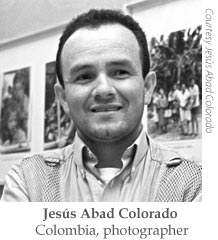|
Jésus Abad Colorado Photographer on the front lines of Colombia’s civil war |
|
Jesús Abad Colorado is a freelance photographer who has witnessed some of the most violent clashes in Colombia’s civil war, capturing powerful images of human rights abuses perpetrated by all sides in the conflict. As a provincial journalist, Colorado knows the adversity faced by colleagues in strife-ridden areas outside the capital, where journalists routinely face threats of reprisal from guerrillas, paramilitaries, and local authorities. Colorado, whose work is widely published in Colombia, has displayed great bravery and determination in reporting from the front line. He was kidnapped twice by leftist guerrillas; in one case, in October 2000, guerrillas of the National Liberation Army abducted Colorado at a roadblock and held him for two days. Colorado won acclaim for his work in the aftermath of a massacre in the town of San José de Apartadó in February 2005. His news account and photographs, published in the national daily El Tiempo, pointed to military involvement in the massacre and a pattern of close military-paramilitary cooperation in the region. The report prompted the attorney general’s human rights unit to further investigate the killings. Colorado’s work has been displayed in more than 30 exhibitions throughout Latin America, Europe, Canada, and the United States. He is a co-author of the 1997 book Accounts and Images, the Forced Displacement. Colorado’s photographs, he says, tell a story of human despair and resilience–and preserve the memory of his country’s troubled recent history. See a slide show of Colorado’s photojournalism
Ever since I started studying journalism in my city, Medellín, 20 years ago, I understood photography as the way to write the life of my country. As a student, I realized that words could challenge the power of arms, corrupt politics, and mafias. Many journalists and intellectuals were being shot or silenced by threats and were forced into exile. The image was another means to tell a story, to get closer to people and the truth. Photojournalism should have a human and aesthetic meaning and, therefore, ethics and respect for others have become the tenets of my journalistic work. As a journalist, I have been a privileged witness in hundreds of moments and places where the war has left its mark. Smoldering, abandoned towns; whole communities forced to leave their homes, their fields, and animals; families asking for their kidnapped or disappeared relatives; people crying for their dead accompanied by a crowd or just surrounded by the jungle. Thousands of children who don’t understand what’s happening and walk on clutching their dogs and chickens, defending the last memory of the plots of land and homes they abandon, often forever. That contact with so many people traumatized by the actions of the armed groups and the proximity to a tragedy that drowns in the indifference of the cities and the impunity of governments triggered in me the interest and the need to work on documenting the recent history of war in Colombia. This photographic testament is a way to fight against war and oblivion. With the passing of time, the images of silence have become a cry that shakes one’s conscience to avoid any more wars. The dignity and resilience of those forgotten calls for solidarity and a pledge to the truth. Every war is a defeat for all of us, no matter if those who suffer are in Africa or the Middle East. I work in Colombia, and I have learned from my parents and teachers that democracy and the practice of journalism is a commitment to life. Thank you. Desde hace 20 anos cuando inicié mis estudios de periodismo en mi ciudad, Medellín, entendí la fotografía como la forma de escribir la vida de mi país. Como estudiante, reconocí el peligro que tiene la palabra para el poder de las armas, el de la política corrupta o las mafias. Muchos periodistas e intelectuales caían bajo las balas asesinas o eran silenciados con amenazas y obligados al exilio. Entonces, la imagen era otra forma de narrar, de estar cercano a la gente y a la verdad. La fotografía de prensa debería tener sentido humano y estético y por ende la ética y el respeto por los demás se convirtieron en el sello de mi trabajo periodístico. Como periodista he sido testigo de excepción en cientos de momentos y lugares donde la guerra ha dejado su huella. Poblados humeantes y abandonados, comunidades enteras condenadas a dejar sus casas, sus sembrados y animales, familias que preguntan por parientes secuestrados y desaparecidos, otros llorando a sus muertos acompañados por la multitud o rodeados solo por la selva. También miles de niños que no entienden lo que ocurre y marchan aferrados a perros y gallinas defendiendo el último recuerdo de las parcelas y los hogares que abandonan, muchas veces, para siempre. Ese contacto con tantas personas golpeadas por las acciones de los grupos armados y la cercanía con una desgracia que se ahoga en la indiferencia de las ciudades y la impunidad de los gobiernos, despertó en mí la inquietud y la necesidad de realizar un trabajo permanente de documentación sobre la historia reciente de la guerra colombiana. Este testimonio fotográfico es una forma de luchar contra la guerra y el olvido. Con el paso de los años, las imágenes del silencio se han convertido en un grito que sacude la conciencia para que no haya más victimas. La dignidad y la resistencia de los olvidados reclaman la solidaridad y el compromiso con la verdad. Cada guerra es una derrota para todos, no importa si los que sufren están en África o en el Medio Oriente. Yo trabajo en Colombia, donde aprendí con mis padres y maestros que la democracia y el ejercicio del periodismo son un compromiso con la vida. Muchas gracias. |

